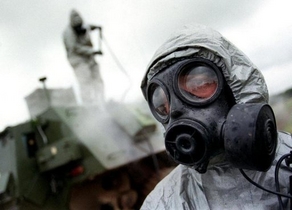
Washington (AFP) – Activity around Syria’s chemical weapons is ringing alarm bells in Washington and other world capitals, but secrecy surrounding the stockpile makes it difficult to gauge its nature and size.
US President Barack Obama on Monday warned Syrian President Bashar Al-Assad “there will be consequences” if he unleashed those weapons in the civil war wracking his country.
A US official told AFP that Syria had begun mixing chemicals that could be used to make sarin, a deadly nerve agent, while CNN reported Damascus could deploy the gas in a limited artillery attack on advancing rebels.
Experts, though, are unable to define the extent of Syria’s chemical weapons arsenal, emphasising that little public information exists. Syria is one of the few countries that has not signed the Chemical Weapons Convention.
Damascus has however signed the Geneva protocol, which bars the first use of chemical and biological weapons, though it does not make stipulations about production, storage and transfer.
“We are closely following information about Syria… but we can’t say more without sending inspectors on the ground,” Michael Luhan, a spokesperson for the Organization for the Prohibition of Chemical Weapons, told AFP.
Intelligence services also have little to say on the subject.
“Syria’s well-established chemical warfare program includes a stockpile of nerve agent, which can be delivered by aircraft or ballistic missiles,” Defense Intelligence Agency chief Lieutenant General Ronald Lee Burgess said in March 2011 testimony before a Senate panel.
“Syria continues to seek chemical warfare-related precursors and expertise from foreign sources.”
Syria is stockpiling “hundreds of tons” of various chemical agents, according to Leonard Spector of the Center for Nonproliferation Studies at the Monterey Institute of International Studies.
“Their panoply of chemical agents is quite robust,” said Olivier Lepick of the Foundation for Strategic Research think tank in Paris.
“They have successfully mastered the synthesis of organophosphorus compounds – the latest, most efficient and most toxic generation of chemical weapons.”
This family of compounds includes sarin and VX nerve agents, as well as older agents such as mustard gas, a mix of sulfur dioxide and ethylene.
Wired.com, a US online magazine, reported in its Danger Room military blog that government engineers in central Syria were thought to have started mixing chemicals last week to make sarin gas. The operation had reached the point where sarin could be loaded on a plane and dropped as a weapon, Danger Room quoted an unnamed US official as saying.
Sarin gas, which cripples the nervous system, was first produced by Nazi scientists in the 1930s and used in two attacks by a Japanese cult in the 1990s. Even a tiny dose can be deadly.
The most notorious sarin attack occurred in 1988 in the village of Halabja in northern Iraq, when as many as 5,000 Kurds were killed and 65,000 injured when the Iraqi military used a combination of chemical agents including sarin, mustard gas and possibly VX.
A radical Japanese cult used Sarin in the Tokyo subway in March 1995 to kill 13 people and injure 6,000 others.
Syria’s program was launched in the 1970s with help from Egypt and later from the former Soviet Union. In the 1990s, Russia lent a hand, followed by Iran since at least 2005, according to the independent Nuclear Threat Initiative.
The Scientific Research Council in Damascus appears to be directing the Syrian chemical weapons program, the NTI said.
The US Congressional Research Service pointed to accessible information suggesting that the production and storage of nerve gas and mustard gas is concentrated in and around the cities of Al-Safira southeast of Aleppo, Damascus, Hama, Homs and Latakia.
Delivery vehicles include Scud ballistic missiles and launch systems, along with aerial bombs and shells, according to publicly-available information.
However, “there is not sufficient information in open sources to draw any conclusions about the security of Syria’s CW arsenal,” the NTI warned.


